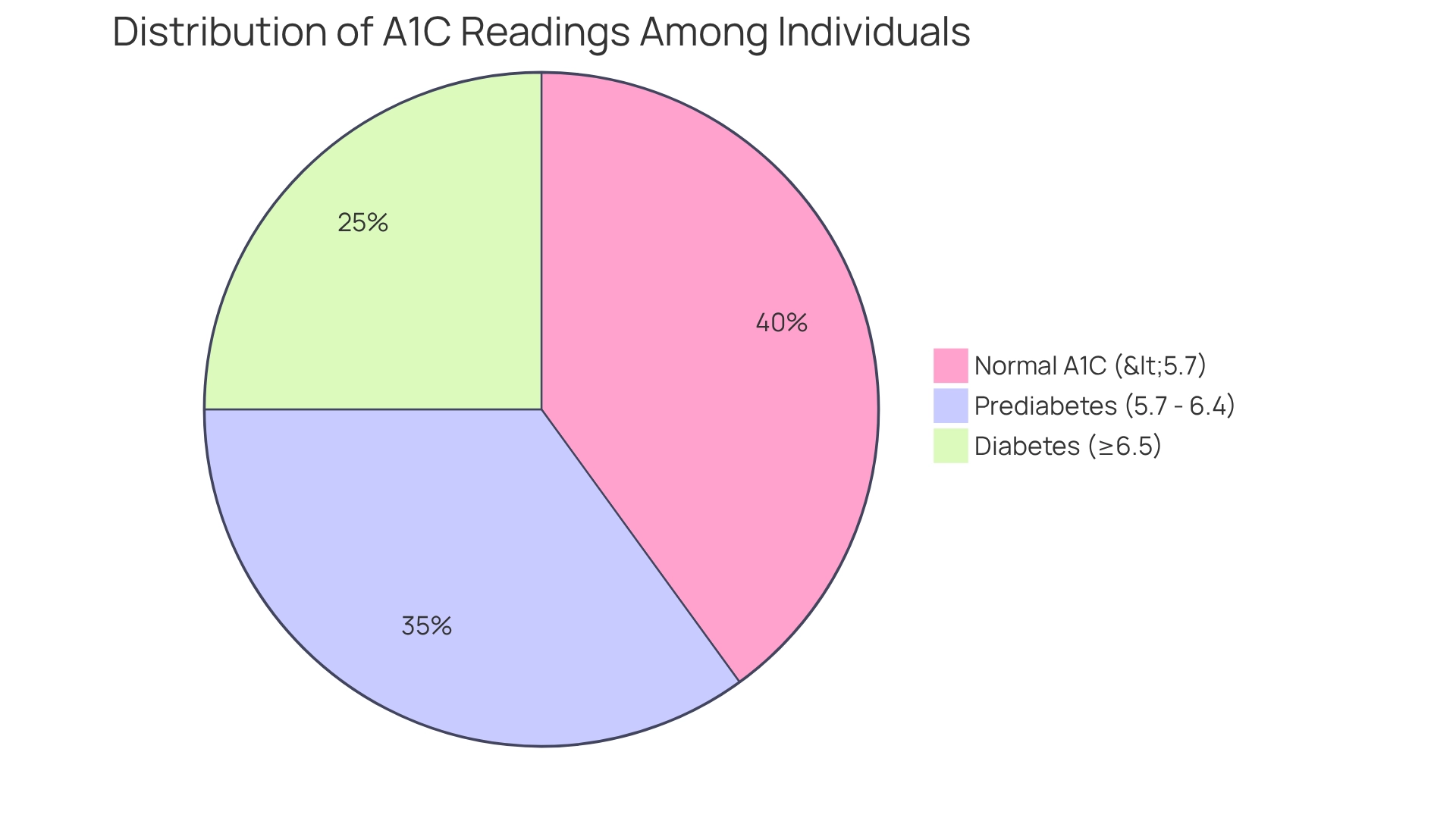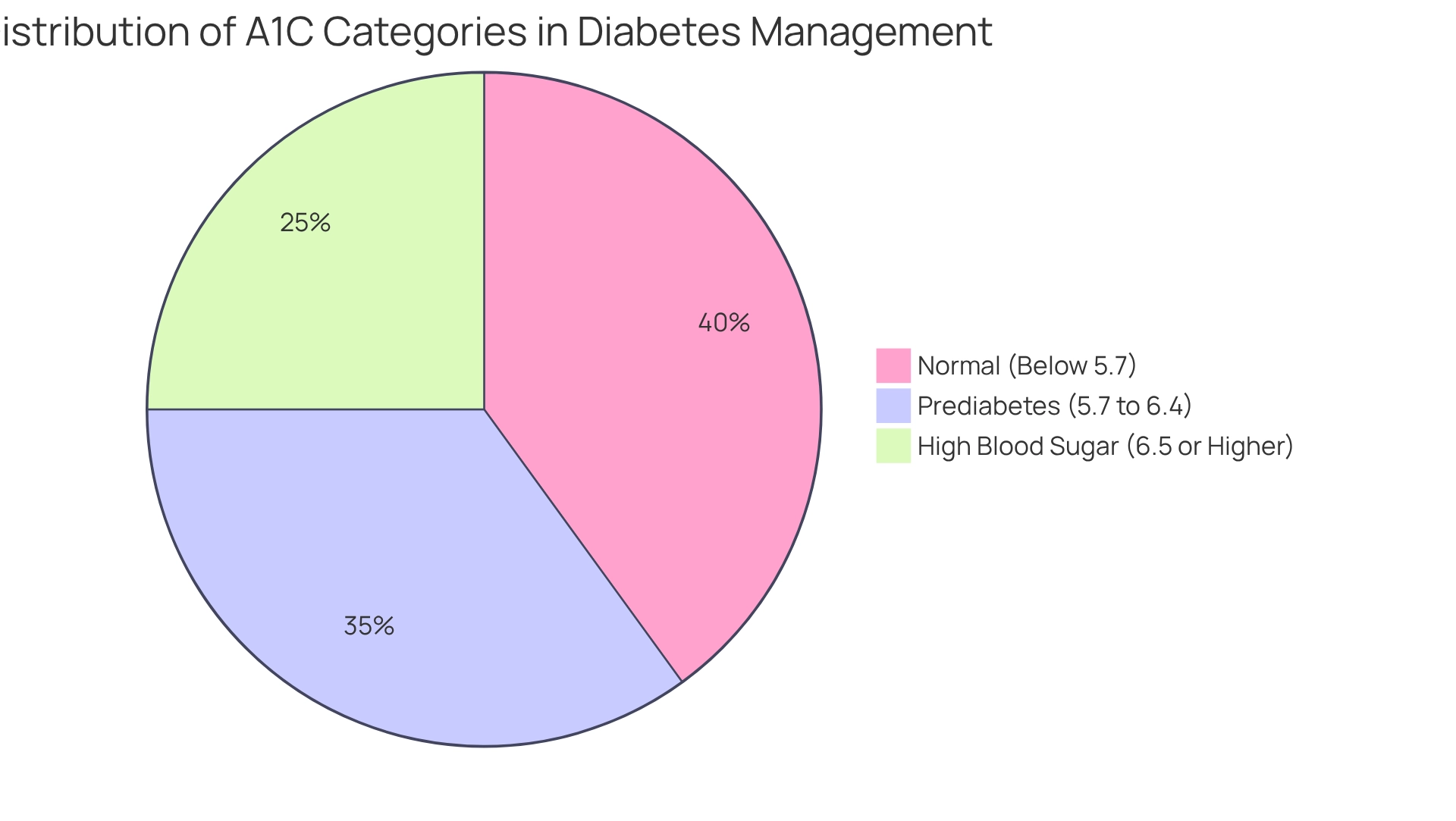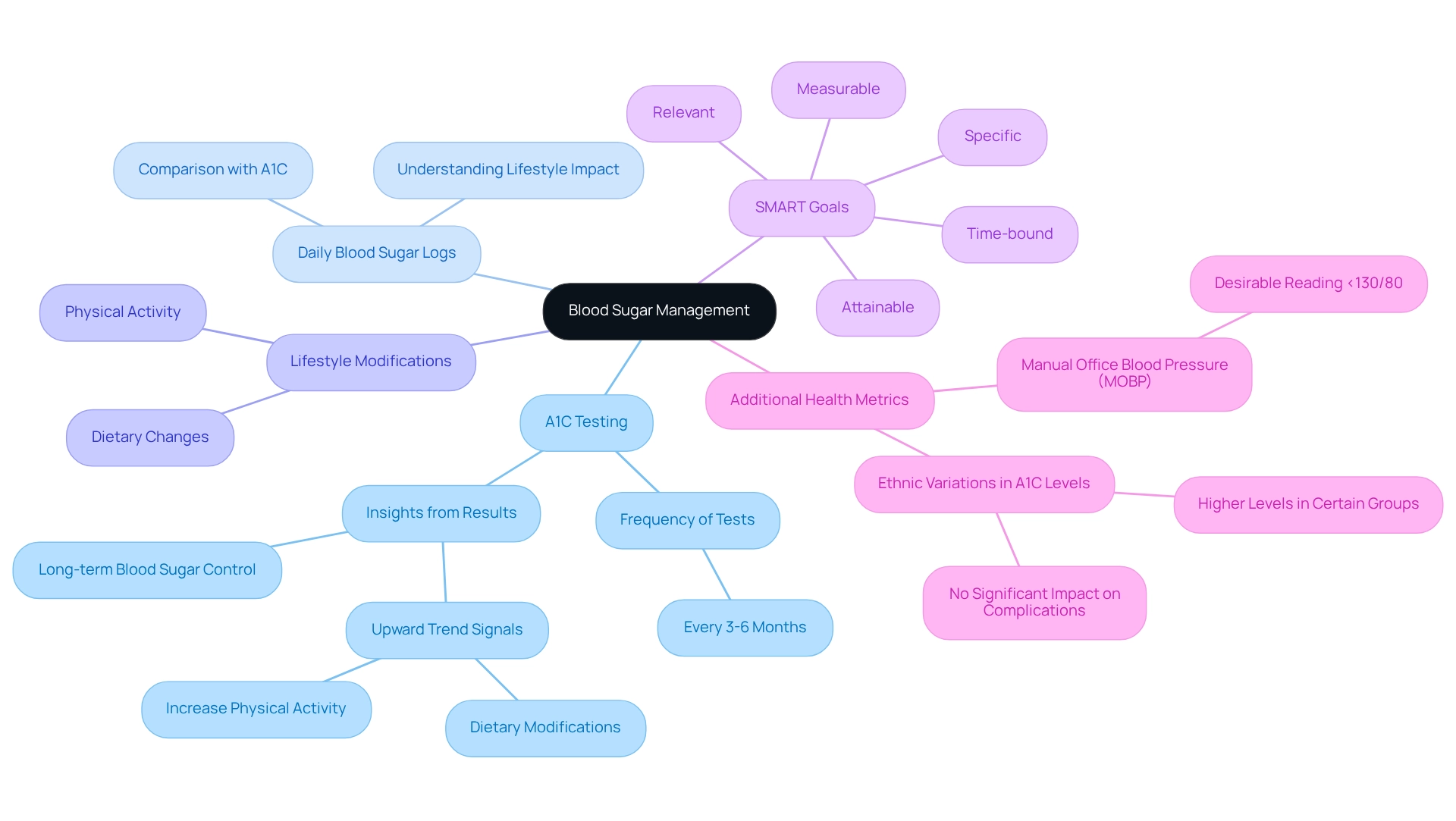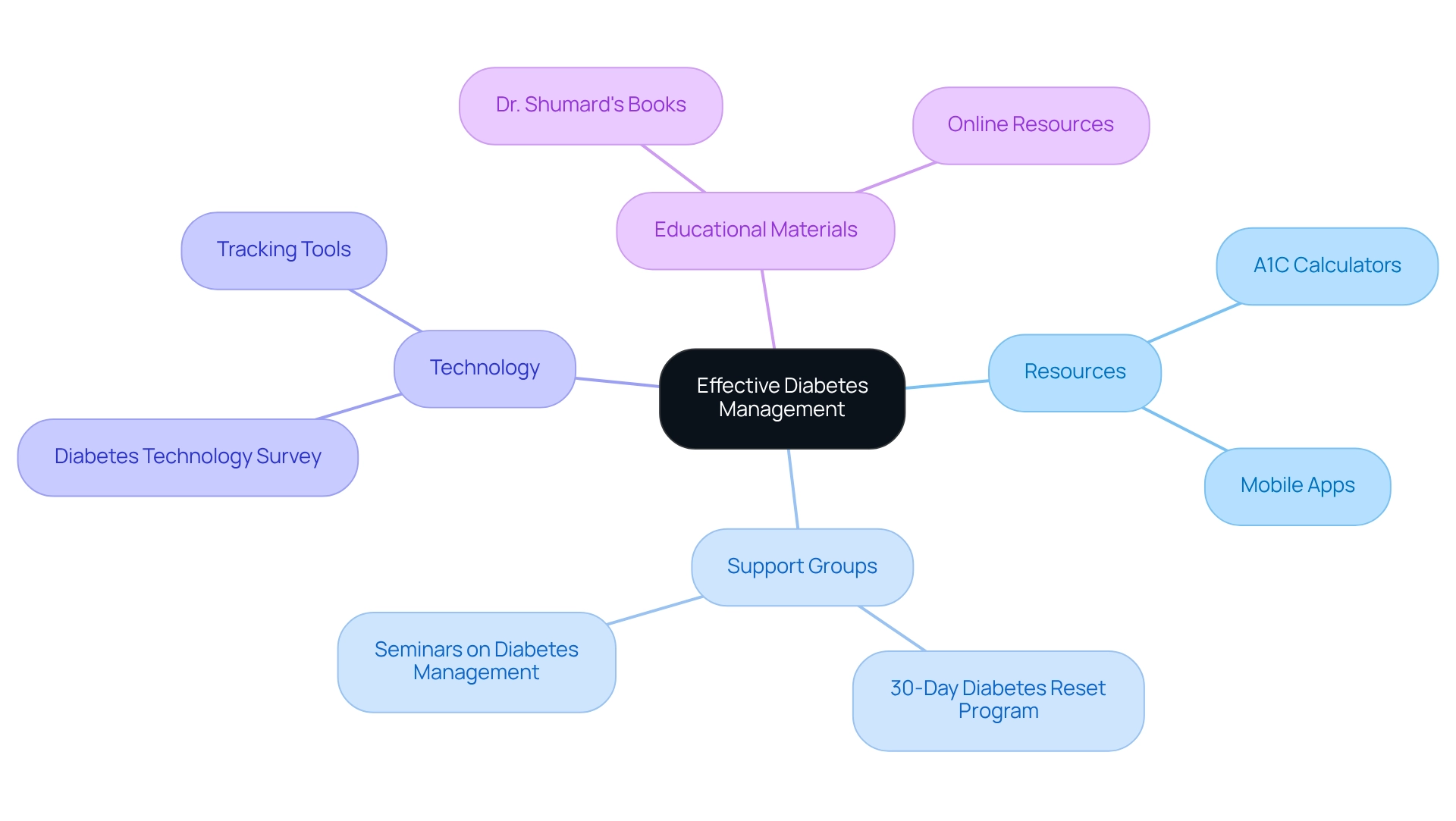Overview
The A1C chart serves as an essential tool for averaging blood sugar levels, reflecting long-term glucose control. It’s important to recognize that this chart can help you understand your diabetes management better.
Regular A1C testing is crucial, and many patients find that lifestyle modifications play a significant role in their health journey.
Utilizing resources such as mobile apps and support groups can empower you in monitoring and improving your blood sugar levels.
Remember, you are not alone in this journey, and there are many ways to support your health and well-being.
Introduction
In the realm of diabetes management, understanding the A1C chart is a critical step for individuals striving to maintain optimal health. This chart not only reflects average blood glucose levels over the past two to three months but also serves as a vital tool for recognizing trends and making informed decisions about one’s health. With the alarming rise in diabetes prevalence, it’s important to recognize that knowledge of A1C levels can empower patients to take proactive steps in managing their condition.
Many patients find that mastering the intricacies of A1C monitoring can lead to improved health outcomes and a better quality of life. From interpreting test results to incorporating lifestyle changes and utilizing modern resources, every bit of knowledge can make a difference. As you embark on this journey, remember that you are not alone; support and guidance are available to help you every step of the way.
Understand the A1C Chart and Its Importance
The A1C chart to average blood sugar is an essential tool for individuals striving to manage their blood sugar levels, reflecting average glucose amounts over the past two to three months. This test measures the percentage of glycated hemoglobin in the blood, offering a clear view of long-term glucose control. Understanding the A1C chart to average blood sugar is essential for recognizing blood sugar trends and making informed health decisions. For instance, an A1C measurement below 5.7% is considered normal, while measurements between 5.7% and 6.4% suggest prediabetes, and those at 6.5% or above confirm a diabetes diagnosis. Familiarity with these ranges empowers patients to take proactive steps in effectively managing their condition.
It’s important to recognize that incorporating holistic lifestyle strategies can significantly enhance the effectiveness of A1C monitoring. Embracing a balanced diet rich in local produce, like avocados and berries, engaging in regular outdoor exercise, and participating in community wellness programs in San Marcos can all contribute to improved blood sugar control. Many patients find that adding seasonal fruits and vegetables from nearby farmers’ markets to their meals provides vital nutrients and fiber, which are beneficial for managing blood sugar.
Recent studies highlight the importance of an A1C chart to average blood sugar in controlling blood sugar levels. Participants in a study identified A1C and blood glucose readings as key indicators of their management success, emphasizing the need for education around these metrics. The emotional impact of managing blood sugar can be significant, and understanding A1C readings can help alleviate some of these challenges by providing clarity and guidance. As Amy T. Cunningham, a specialist in blood sugar regulation, expressed, “I just want to be an inspiration for someone who’s going through the same thing that I’m experiencing. So, I can make it out of this. And if I can do it, they can do it.”
Data from 2025 indicate that many individuals with this condition struggle to keep A1C values within the recommended range, underscoring the necessity for comprehensive education and support. Healthcare providers often recommend using an A1C chart to average blood sugar in conjunction with daily blood glucose monitoring to achieve a holistic understanding of glucose control. This multifaceted approach not only aids in tracking progress but also fosters a sense of empowerment among patients.
Incorporating insights from specialists in blood sugar management, it’s clear that the A1C test is not just a number; it represents a pathway to better health. The case study titled ‘Understanding A1C and Blood Glucose as Success Markers’ emphasizes how participants acknowledged A1C and blood glucose levels as crucial for evaluating their success in managing their condition. By effectively using the A1C chart to average blood sugar and integrating lifestyle changes such as personalized nutrition and stress reduction techniques, patients can enhance their health strategies, ultimately leading to improved health outcomes and a better quality of life. Moreover, monitoring progress through tools like fitness applications and establishing SMART objectives can further empower patients on their health management journey.
Interpret Your A1C Results Accurately
To accurately interpret your A1C results, start by noting the percentage reported on the A1C chart to average blood sugar. For instance, according to the A1C chart to average blood sugar, an A1C of 7% corresponds to an average blood glucose concentration of approximately 154 mg/dL. Understanding where your results fall within standard ranges is crucial:
- Below 5.7% is considered normal
- 5.7% to 6.4% indicates prediabetes
- 6.5% or higher confirms a diagnosis of high blood sugar, which can be monitored through an A1C chart to average blood sugar.
Regular conversations with your healthcare provider are vital to grasp the implications of your results on your treatment plan.
It’s essential to recognize that factors such as recent illnesses or changes in medication can influence your A1C levels. Many patients find that consistent monitoring and a clear understanding of the A1C chart to average blood sugar can empower them to take charge of their health. As David M Maahs from Stanford University notes, keeping A1C within target ranges is crucial for improving overall health and reducing complications associated with this condition. Additionally, addressing systemic barriers in glucose regulation is critical, particularly for marginalized populations, as highlighted in recent research advocating for comprehensive interventions.
Integrating effective methods for tracking your progress, like using fitness apps, notebooks, and step counters, can significantly enhance your health oversight. Have you considered setting SMART goals—specific, measurable, attainable, relevant, and time-bound? For example, you might aim to lower your A1C by a certain percentage within a specified timeframe or gradually increase your physical activity. Research shows that persistence in goal-setting can positively affect performance; for instance, scores improved from 3.4 (SD = 2.0) to 3.8 (SD = 1.9) under specific conditions, illustrating the power of structured goal-setting. By accurately interpreting your A1C results and consulting your healthcare team if they fall outside the target range, you can use the A1C chart to average blood sugar to navigate your diabetes management journey more effectively. Regularly evaluating your progress not only fosters accountability but also allows for the adjustment of goals in response to changing fitness standards.
Apply the A1C Chart to Monitor Blood Sugar Levels
To effectively utilize a1c chart to average blood sugar levels, it’s important to schedule regular A1C tests as advised by your healthcare provider, typically every three to six months. These tests offer valuable insights into your long-term blood sugar control. If you notice an upward trend in your A1C results, it may signal the need for dietary modifications or an increase in physical activity.
Many patients find that maintaining a daily log of their blood sugar readings can be beneficial. By comparing these daily measurements with your A1C chart to average blood sugar results, you can better understand how lifestyle changes influence your overall glucose management. This proactive approach not only helps you stay focused but also empowers you to make informed choices regarding your well-being, ultimately leading to improved management of your condition. Consider implementing SMART goals—specific, measurable, attainable, relevant, and time-bound—to enhance your focus and motivation. For instance, you might set a goal to lower your A1C by a certain percentage within a specific timeframe.
It’s also essential to track other health metrics, such as blood pressure, with a suggested Manual Office Blood Pressure (MOBP) reading of less than 130/80 for individuals with this condition. Understanding these additional factors can provide a more comprehensive perspective on your health. Furthermore, it’s important to recognize that A1C levels can differ among various ethnic groups, which is crucial for personalized blood sugar control. Studies indicate that while A1C concentrations may vary, they do not significantly alter the association between A1C and diabetes-related complications. As Dr. Jason Shumard emphasizes, ‘By providing patients with actionable insights and practical tools, the center fosters an environment where individuals can reclaim their health and well-being.’ This highlights the significance of customized strategies in blood sugar care.
Integrating these insights into your monitoring routine can enhance your understanding of healthcare and support your journey towards better well-being.
Utilize Resources and Tools for Effective Diabetes Management
To enhance your health oversight, it’s important to recognize the variety of resources and tools available to you. Have you considered using A1C conversion calculators, like those provided by the American Diabetes Association? These tools can help you accurately interpret how your A1C levels relate to the A1C chart to average blood sugar levels. This understanding is crucial, especially in light of the astonishing 338% rise in adults with high blood sugar levels, which highlights the need for effective control strategies.
At Integrative Wellness Center, we offer transformative services designed to help you move away from reliance on insulin and other medications related to high blood sugar. Many patients find that joining support groups or attending seminars focused on diabetes management significantly enhances their journey. These platforms not only provide insights from the experiences of others but also foster a sense of community and shared knowledge that can lead to improved A1C outcomes. For instance, transformative patient experiences shared by individuals who have participated in Dr. Jason Shumard’s 30-Day Diabetes Reset program illustrate how education and support can empower you to overcome challenges associated with type 2 diabetes.
Incorporating mobile apps designed for tracking blood sugar levels and dietary intake can also be a game-changer. These tools can help you monitor your progress and offer reminders and tips for maintaining healthy habits. Have you noticed the growing interest in technology for managing diabetes-related conditions? This trend underscores the importance of utilizing these modern solutions to enhance your management strategies.
Lastly, consider consulting educational materials, including Dr. Shumard’s books, which provide in-depth knowledge about managing these health issues. As health educators emphasize, understanding how to effectively use the A1C chart to average blood sugar can empower you to take control of your well-being, equipping you with the information needed to make informed decisions. By actively engaging with these tools and resources, you can deepen your understanding of diabetes and improve your overall health outcomes.
Conclusion
Understanding and effectively utilizing the A1C chart is crucial for anyone managing diabetes. It reflects average blood glucose levels over time and empowers individuals to make informed health decisions. By recognizing the significance of A1C levels, patients can identify trends, adjust their lifestyle choices, and engage in proactive health management.
It’s important to recognize that the journey to better diabetes control involves:
- Accurately interpreting A1C results
- Setting SMART goals
- Consistently monitoring both A1C and daily blood glucose levels
Many patients find that integrating lifestyle modifications—such as a balanced diet and regular exercise—can significantly enhance overall health outcomes. Additionally, leveraging modern tools and resources, from mobile apps to support groups, can provide the necessary guidance and community support essential for navigating the complexities of diabetes management.
Ultimately, knowledge is power in the realm of diabetes. By embracing the insights offered by the A1C chart and committing to continuous learning and self-monitoring, individuals can take significant strides toward achieving their health goals. This proactive approach not only leads to improved A1C levels but also fosters a better quality of life, empowering patients to reclaim their health and well-being.
Frequently Asked Questions
What is the A1C chart to average blood sugar?
The A1C chart to average blood sugar is a tool that reflects average glucose levels over the past two to three months by measuring the percentage of glycated hemoglobin in the blood, providing insight into long-term glucose control.
Why is understanding the A1C chart important?
Understanding the A1C chart is essential for recognizing blood sugar trends and making informed health decisions, as it helps individuals manage their blood sugar levels effectively.
What do different A1C measurements indicate?
An A1C measurement below 5.7% is considered normal, 5.7% to 6.4% suggests prediabetes, and 6.5% or above confirms a diabetes diagnosis.
How can lifestyle changes impact A1C monitoring?
Incorporating holistic lifestyle strategies, such as a balanced diet rich in local produce, regular outdoor exercise, and participation in community wellness programs, can significantly enhance the effectiveness of A1C monitoring.
What role do A1C and blood glucose readings play in diabetes management?
A1C and blood glucose readings are key indicators of management success, and understanding these metrics can help individuals better manage their condition and alleviate emotional challenges.
What do recent studies suggest about A1C values?
Recent studies indicate that many individuals struggle to keep A1C values within the recommended range, highlighting the need for comprehensive education and support in diabetes management.
How should the A1C test be used in conjunction with other monitoring?
Healthcare providers recommend using the A1C test alongside daily blood glucose monitoring to achieve a holistic understanding of glucose control and track progress effectively.
What does the A1C test represent for individuals managing their health?
The A1C test represents more than just a number; it serves as a pathway to better health by helping individuals evaluate their success in managing their condition and guiding them in making necessary lifestyle changes.
How can technology assist in health management related to A1C?
Tools like fitness applications can help monitor progress, and establishing SMART objectives can empower patients on their health management journey.



